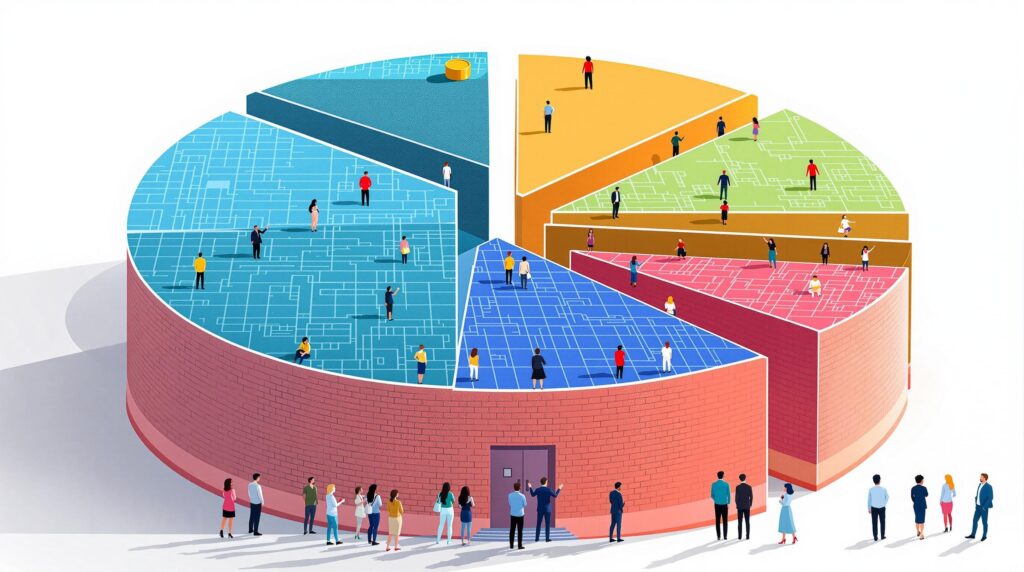[rev_slider alias=”slider-1″][/rev_slider]
Understanding Layer 1 Blockchains
Layer 1 blockchains serve as the foundational architecture for cryptocurrencies, providing the primary structure upon which other platforms and applications build. These blockchains are responsible for transaction processing, network security, and consensus mechanisms.
Key Features of Layer 1 Blockchains
Layer 1 blockchains are characterized by three major features that ensure their functionality and efficiency: decentralization, speed, and security. Let’s break them down to understand their importance:
- Decentralization: This is the essence of blockchain technology. A decentralized network means that no single entity has control over the entire network. Instead, it relies on a distributed network of nodes to validate transactions and secure the network. Decentralization reduces the risk of single points of failure and increases trust among users.
- Speed: Speed, or transaction throughput, is crucial in determining how quickly a blockchain can process and confirm transactions. Some Layer 1 blockchains, like Solana and Avalanche, have optimized their consensus algorithms to process thousands of transactions per second, which is essential for scalability and mass adoption.
- Security: Layer 1 blockchains use cryptographic techniques to ensure the integrity and security of transactions. The consensus mechanism plays a pivotal role here, as it dictates how transactions are validated and confirmed. Security is non-negotiable, especially in financial transactions, which makes robust security protocols a must-have feature.
Decentralization in Layer 1 Blockchains
Why is decentralization crucial in blockchains? Decentralization removes the control of a single authority, leading to greater transparency and trust. This lack of centralized control ensures resistance to censorship and potential corruption. By having a network spread across various nodes worldwide, Layer 1 blockchains can ensure that data is secure and immutable, effectively changing the way data ownership and control are viewed. Would you trust a network that isn’t decentralized?
Decentralization in Layer 1 blockchains enables resilience and trust by eliminating single points of failure and distributing control across a global network.
Speed and Efficiency of Layer 1 Blockchains
Layer 1 blockchains like Ethereum and Bitcoin aim to provide a balance between speed and security. Still, they often struggle with scalability. Newer blockchains such as Solana address these issues using unique consensus mechanisms, such as Proof of History (PoH) integrated with Proof of Stake (PoS), enabling them to process extensive transactions efficiently.
Why does speed matter in blockchain? Consider the analogy of a busy highway. Just as more lanes help accommodate more cars without traffic jams, a blockchain with higher transaction throughput allows for more transactions per second without delays, which is crucial for applications requiring quick transaction confirmations. Slow transaction speeds can deter users, especially with increasing demand for digital transactions.
Security Protocols in Layer 1 Blockchains
Security is paramount in blockchain technology, and Layer 1 blockchains employ rigorous security measures to protect against vulnerabilities. Technologies like cryptographic hashing, digital signatures, and consensus algorithms like Proof of Work (PoW) and PoS contribute to a secure environment. By leveraging these advanced security measures, Layer 1 blockchains maintain the sanctity of data and transactions, ensuring users’ trust and preventing fraudulent activities.
Security in Layer 1 blockchains is achieved through robust cryptographic techniques and consensus mechanisms, safeguarding against fraud and ensuring data integrity.
Emphasizing these critical features can help investors and developers understand why some blockchains are faster and more secure than others. As the digital asset ecosystem in Africa grows, platforms like Jara are harnessing these technologies to build foundational infrastructure integral to the region’s economic future.
Incorporating advanced technologies and enhanced functionalities in its Layer 2 solutions, Jara is positioned to meet Africa’s immense market’s demand while facilitating a more inclusive financial infrastructure. Jara is not just a platform; it’s a movement toward comprehensive financial empowerment in Africa.
Reasons for Speed Variations in Layer 1 Blockchains
Layer 1 blockchains vary in speed due to several factors that influence their overall performance. These factors are crucial in determining how efficiently blockchains can handle transactions. Key considerations include the choice of consensus mechanisms, block size, and network bandwidth. Each of these elements plays a vital role in enhancing transaction throughput and ensuring network efficiency.
Consensus Mechanisms and Their Impact
The consensus mechanism employed by a blockchain is one of the most significant determinants of its speed and scalability. But what exactly is a ‘consensus mechanism’? In simple terms, it is the process by which transactions are verified and agreed upon before being added to the blockchain. Two popular methods are Proof of Work (PoW) and Proof of Stake (PoS).
What is Proof of Work? Proof of Work is a consensus mechanism where nodes solve complex mathematical puzzles to validate transactions and add them to the blockchain. This process requires high computational power and energy, making it slower compared to other mechanisms.
What is Proof of Stake? Proof of Stake is a consensus mechanism that assigns transaction validation rights based on the number of coins held by a node. This method is generally faster as it does not require solving complex equations, reducing energy consumption and improving transaction speed.
The choice between PoW and PoS can significantly affect a blockchain’s performance. For instance, PoW, used by Bitcoin, tends to be slower due to its computational demands. Conversely, PoS, used by Ethereum after its transition with the Ethereum 2.0 upgrade, facilitates faster transactions by eliminating the need for solving complex puzzles. This shift to PoS allows blockchain systems to improve their scalability and speed, making them more suited for a broad range of applications.
- Energy Efficiency: PoS is generally more energy-efficient than PoW, reducing environmental impact.
- Scalability: PoS supports higher throughput, essential for handling larger networks without delays.
- Security: Both mechanisms offer robust security, but PoS reduces the risk of 51% attacks, where a single entity gains control over more than half of the network’s hash rate.
- Cost-Effectiveness: PoS reduces the infrastructure costs associated with mining hardware in PoW setups, making it an economically viable solution.
For those interested in exploring the legal implications of blockchain technologies, our detailed analysis on defense of crimes involving Bitcoin and cryptocurrency could provide valuable insights into the intricacies of blockchain legality.
Block Size Considerations
Another critical factor affecting blockchain speed is the block size. Larger block sizes allow more transactions to be recorded within a single block, increasing overall throughput. However, it also demands higher storage and processing power from network participants, which can be a bottleneck for some systems.
Why is Block Size Important? Block size directly influences a blockchain’s capacity to handle transactions. A larger block size can improve throughput but may lead to increased latency and require more significant computational resources.
In scenarios where high transaction rates are essential, such as for Jara’s economic empowerment projects in Africa, optimizing block size for faster processing becomes a priority. By facilitating rapid and seamless transactions, projects like the tokenization of the Lagos airport bond can enhance financial inclusion and market efficiency.
Network Bandwidth and Its Influence
The bandwidth available to a network profoundly impacts its transaction speed and efficiency. A network with higher bandwidth can handle more data, resulting in quicker transaction confirmations. However, it requires robust infrastructure to maintain the speed and reliability needed for consistent performance.
How Does Network Bandwidth Affect Blockchains? Network bandwidth determines data transmission speed across the blockchain, affecting both transaction processing time and overall network latency.
In the rapidly growing African digital asset market, ensuring optimal network bandwidth is key to supporting scalable and reliable blockchain solutions. Jara, by leveraging advanced blockchain architecture, can offer low-cost access to asset digitization and cross-border transactions, empowering users and fostering economic growth.
As we navigate these technological landscapes, understanding the foundational components of blockchain technology enhances our ability to harness its potential for transformative economic development. For further reading on integrating these technologies into legal frameworks, visit BengalLaw’s insights on integrating tech advancements.
[rev_slider alias=”text-call-cta”][/rev_slider]
The Importance of Blockchain Speed
In the rapidly evolving world of blockchain technology, speed is a critical factor that can determine the success or failure of a platform. Imagine waiting in a long queue for a simple coffee when a faster service is right around the corner. Similarly, a blockchain’s speed affects user experience, scalability, and adoption rates, just like faster service enhances customer satisfaction.
Effects on User Adoption
The quest for speed in blockchain is not just about winning a technological race; it’s about creating a friendly and efficient environment for users and developers alike. Wouldn’t you prefer to engage with a platform that processes transactions at lightning speed? That’s exactly what influences user adoption. Fast blockchains minimize waiting times and enhance user satisfaction, making them more attractive to potential users looking to simplify their digital interactions.
Network Scaling and Efficiency
As more people around the globe embrace digital transactions, blockchains face the pressing challenge of scalability. Much like expanding roads to accommodate more traffic, blockchains need to manage increased transaction loads efficiently. Faster blockchains can handle more transactions per second, meaning they can easily accommodate growing user demands without compromising network efficiency. This is particularly crucial in densely populated regions like Africa, where digital financial services are gaining momentum.
What is Blockchain Speed? Blockchain speed refers to the number of transactions a blockchain can process per second, ensuring quicker execution and confirmation of transactions.
Impact on Platform Adoption
Why do some platforms succeed while others fizzle out? Often, the answer lies in their adoption rates. Faster blockchains attract more developers and projects, as they can offer seamless transaction experiences. This, in turn, creates a snowball effect, where increased participation fosters further platform development and innovation. In essence, faster speeds can lead to a more vibrant and diverse ecosystem, enhancing the value of token usage within the network.
The $JARA token highlights this principle by positioning itself within Jara’s vibrant ecosystem, offering swift transactions on its proprietary Layer 2 blockchain and fueling Africa’s digital revolution.
Reduction in Costs and Resources
Ever wonder why your internet or mobile charges fluctuate? The principle is somewhat similar in blockchain systems. Faster networks often mean reduced energy consumption per transaction, which can translate into cost savings. For a continent like Africa, where energy resources can be scarce and expensive, optimizing blockchain speed can play a pivotal role in making digital transactions more accessible and sustainable.
Reliability and Security Enhancement
Would you trust a bank that takes forever to approve your transaction? Just like in traditional finance, blockchain users demand reliability and security. Faster blockchains reduce the time a transaction is vulnerable to attacks, thereby enhancing security. The speed ensures that transactions are validated before malicious entities can interfere, boosting user trust in digital assets and platforms.
“Speed is of the essence.” Rapid transaction processing bolsters platform integrity, promoting greater trust among users.
Applications Beyond Financial Transactions
While most of us associate blockchains with cryptocurrencies like $JARA, their applications extend far beyond financial transactions. Fast blockchains are paving the way for innovations in areas like supply chain management, healthcare, and even entertainment. The ability to process and verify data quickly opens new doors for how we store, share, and utilize information across various sectors.
Conclusion
In conclusion, blockchain speed is more than just a technical parameter; it’s a game-changer in the digital landscape. As we increasingly rely on digital solutions for everyday transactions, fast blockchains like those utilized by the Jara platform stand out by meeting user expectations and fostering innovation. They are crucial in bridging global capital to African assets, forming a cornerstone of the continent’s burgeoning digital asset economy.
Comparing Layer 1 and Layer 2 Solutions
Understanding the differences between Layer 1 and Layer 2 blockchain solutions is crucial for optimizing blockchain technology for speed and efficiency. Layer 1 blockchains, such as Bitcoin and Ethereum, operate as foundational networks. In contrast, Layer 2 solutions build on top of these networks, offering additional scalability without sacrificing the main network’s security and decentralization.
Layer 2 Advantages
Layer 2 protocols address several limitations associated with Layer 1 blockchains. They enhance processing speed by offloading transactions from the main chain, which alleviates congestion and often reduces transaction costs. This allows Layer 1 networks to maintain their security integrity while scaling their transaction capacity.
What are Layer 2 Solutions? Layer 2 solutions are secondary frameworks or protocols built on top of existing blockchains to enhance processing speed and efficiency without compromising security.
There are many reasons why implementing Layer 2 solutions can be advantageous:
- Scalability: By processing transactions off-chain, Layer 2 solutions increase the throughput of the overall system.
- Cost Efficiency: Reduced transaction costs offer a more economical choice for users.
- Improved User Experience: Faster transaction times lead to smoother user interactions, important for any thriving blockchain ecosystem.
- Security: Offloading transactions to Layer 2 does not compromise the underlying network’s security.
In regions like Africa, where digital transformations are ripe and demand for efficient financial services is booming, such solutions can ensure vast populations gain better financial accessibility. As Africa continues to embrace blockchain technology, applications like the Jara app play a pivotal role in bridging technological gaps.
The Potential of Layer 2 in Africa: By utilizing Layer 2 technologies, Africa can forge new paths toward broader financial inclusion and increased economic empowerment.
Layer 2 solutions are not just technical enhancements; they represent a transformative approach to how blockchain networks can evolve. As more blockchain applications find their footing in varying industries, the interoperability between Layer 1 and Layer 2 technologies might define how successfully these applications can scale and serve diverse markets. For instance, the $JARA token, with its dual-layer approach, exemplifies the potential benefits of adopting Layer 2 technology to optimize Africa’s digital asset economy. For more insights into how blockchains serve different industries, check resources like cryptocurrency legal defense.
[rev_slider alias=”schedule-consultation-btn”][/rev_slider]

How do Layer 1 and Layer 2 blockchain solutions differ?
Layer 1 blockchains form the base architecture of a network, handling essential functions like transaction processing and consensus mechanisms. In contrast, Layer 2 solutions operate on top of these blockchains to improve scalability and speed by offloading transactions.
What factors influence the speed of a Layer 1 blockchain?
The speed of a Layer 1 blockchain is affected by its consensus mechanism, block size, and network bandwidth. For instance, Proof of Stake is generally quicker than Proof of Work due to simpler computations.
Why is the speed of blockchains important?
Blockchain speed is crucial as it affects user experience, transaction costs, and the overall efficiency of the network. Faster blockchains can handle more transactions per second, leading to expanded adoption and lower costs for users.
What are some examples of Layer 2 solutions improving blockchain scalability?
Examples of Layer 2 solutions improving scalability include the Lightning Network for Bitcoin, which allows off-chain transactions. These solutions enable higher transaction throughput without the need for scaling the main blockchain itself.

Related Practice Areas
Explore our other practice areas and resources that expand on blockchain technology and its implications, providing deeper insights for interested parties.
Discover What Our Clients Are Saying
Serving our Layer 1 and Layer 2 blockchain solutions clients with complete dedication, every case is a testament to our hard work. The appreciative feedback we receive underscores our commitment to excellence.

[rev_slider alias=”slider-3″][/rev_slider]
[rev_slider alias=”slider-6″][/rev_slider]
Why Choose Jara for Your Blockchain Needs?
Looking to harness the power of blockchain innovation? At Jara, we specialize in unlocking the potential of both Layer 1 and Layer 2 blockchain solutions. Our expert team is dedicated to providing tailored strategies that amplify the efficacy of blockchain technologies, ensuring rapid transactions and unmatched security.
Don’t just take our word for it. Explore our recognition as industry leaders and see why our clients trust us with their blockchain endeavors.
Awards and Recognitions in Blockchain Solutions
- Recognized among the “Top FinTech Disrupters of 2023” by Tech Innovations Network for our impactful blockchain solutions. Link to Award
- Listed as a pioneer in “Emerging Blockchain Leaders in Africa” by African Blockchain Consortium, highlighting our commitment to regional technological growth. Link to Award
- Highlighted among the “Best Decentralized App Developers” for 2023 in App Development Today, reflecting our unparalleled expertise in app development for blockchain technologies. Link to Award
- Named as one of the “Leading Blockchain Innovators” in the 2023 report by Global Tech Unearth, acknowledging our innovative approach to Layer 1 and Layer 2 solutions. Link to Award
- Lauded for being in the “Top Digital Economy Builders” of 2023 by Digital Africa Focus, showcasing our role in advancing digital infrastructure. Link to Award
To experience the Jara advantage and propel your blockchain projects forward, download the Jara app today for Android or iPhone and let’s innovate together!
Chinyere “Chi” Nnadi Bio
Founder and CEO, Jara | Blockchain Technology Specialist
Content Reviewed by Chi Nnadi and his Content Team. Chi is a pioneering entrepreneur committed to revolutionizing Africa’s financial systems through innovative blockchain solutions. As the brain behind Jara, he develops robust infrastructure that turns traditional African assets into globally recognized digital tokens. His expert insights into Layer-2 blockchain applications are bridging the gap between international investors and Africa’s burgeoning digital marketplace.
Our Content Review Process
Chi Nnadi together with Jara’s expert content team is dedicated to delivering premium quality content. Our meticulous guidelines guarantee thorough research, reliable sources, and objective analysis, ensuring the utmost in accuracy and depth. If you spot any inaccuracies, please let us know.
















